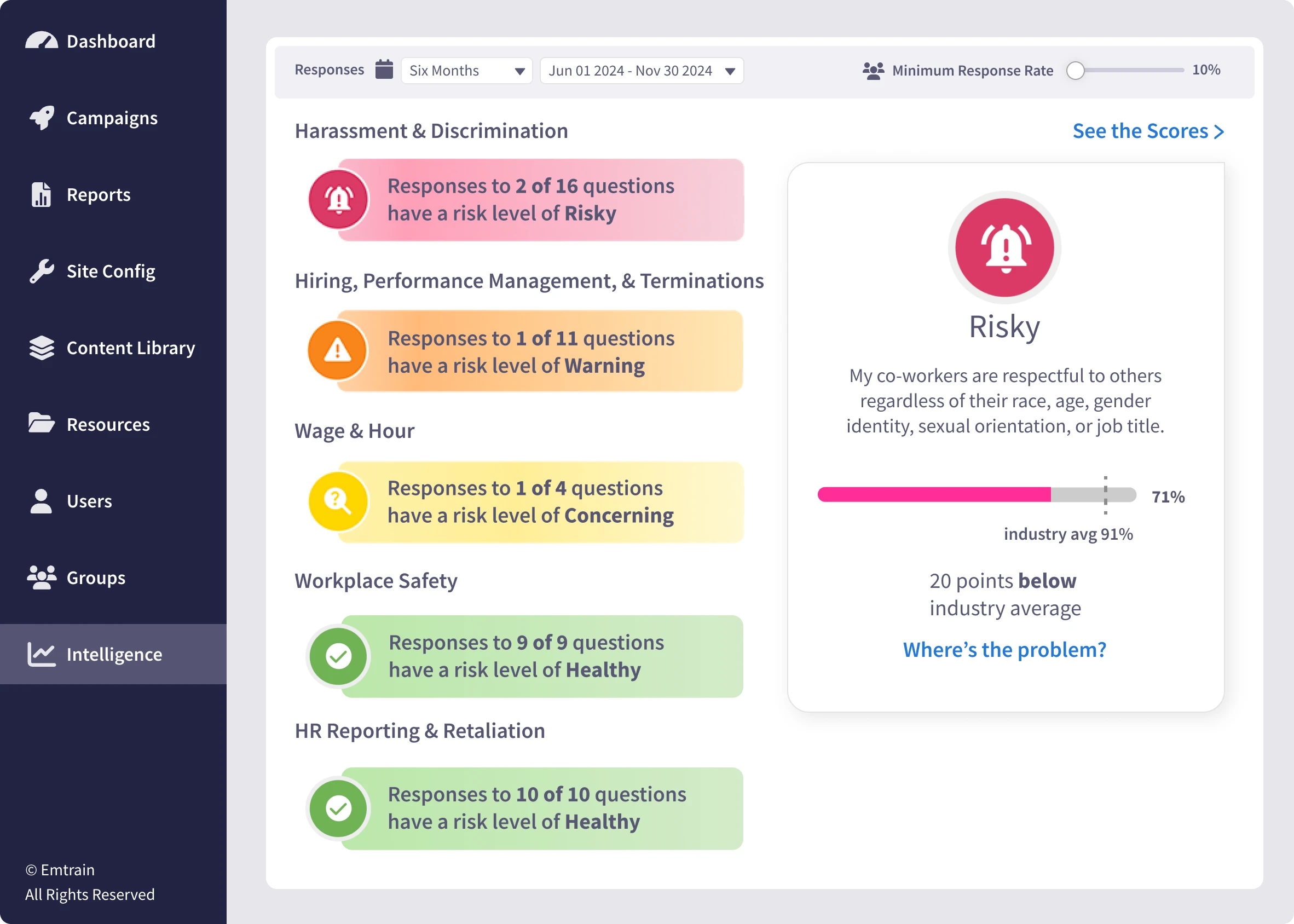Home » Concepts » Discrimination & Harassment » AA (Affirmative Action)
Affirmative Action refers to policies and practices aimed at increasing opportunities for historically underrepresented groups — particularly in employment and education — to create a more inclusive and equitable environment. These initiatives promote fairness by addressing structural disadvantages and ensuring broader representation in hiring, promotion, and educational admissions.
Emtrain’s harassment training course is engaging, interactive, and designed to spot and reduce EEO risk.

Affirmative Action was formally introduced during the Civil Rights era, particularly with Executive Order 11246 (1965), which required federal contractors to take affirmative steps to ensure equal employment opportunity regardless of race, color, religion, sex, or national origin. Over time, Affirmative Action policies expanded to promote inclusion for women, veterans, individuals with disabilities, and LGBTQ individuals.
However, on January 21, 2025, Executive Order 14173 revoked Executive Order 11246, effectively ending federal affirmative action requirements for race and gender among federal contractors. Despite this change, many organizations continue to pursue diversity and inclusion efforts as part of their values and workplace culture.
At its core, Affirmative Action is a proactive approach to ensure fair access to opportunities by encouraging organizations to recruit, retain, and advance individuals from groups historically excluded from equal participation.
Today, Affirmative Action is not universally required for all employers:
Federal contractors and subcontractors are no longer required to maintain Affirmative Action Plans (AAPs) for race or gender following the revocation of Executive Order 11246.
Affirmative Action obligations under other laws remain, such as Section 503 of the Rehabilitation Act (individuals with disabilities) and VEVRAA (protected veterans).
Many employers voluntarily maintain Affirmative Action programs to promote diversity and equity in the workplace.
An Affirmative Action Plan (AAP) is a structured, written program designed to promote equal employment opportunity and ensure that organizations proactively identify and remove barriers to equal participation by underrepresented groups.
While federal contractors are no longer required to maintain AAPs for race and gender as of January 2025, an AAP remains a useful framework for organizations that voluntarily pursue inclusion goals or must comply with other federal or state requirements (such as AAPs for veterans and individuals with disabilities).
A typical Affirmative Action Plan includes:
Organizational profile:
A workforce analysis showing how employees are distributed across jobs, departments, and levels.
Job group analysis:
Grouping jobs by similar content, wage rates, and opportunities to facilitate comparison of representation.
Availability analysis:
Assessment of the availability of women and minorities qualified for employment, based on labor market data.
Placement goals:
Targets set when underrepresentation is identified — not quotas — to encourage outreach and hiring efforts.
Action-oriented programs:
Specific steps to recruit, hire, promote, and retain underrepresented groups (e.g., outreach to diverse professional organizations or colleges).
Internal audit and reporting system:
Mechanisms for tracking progress, evaluating results, and ensuring accountability at leadership levels.
Policy statements:
Clear statements of equal employment opportunity (EEO) policy and management commitment.
Strategies for supporting specific groups:
Black employees: Ensure equitable hiring, mentoring, and advancement; support Black Employee Resource Groups (ERGs).
Women: Address gender pay equity; remove maternal wall bias; promote women in leadership.
Individuals with disabilities: Provide accommodations; ensure accessibility; inclusive hiring practices.
Asians: Challenge stereotypes and unconscious bias.
Muslims: Accommodate religious practices; prevent Islamophobia.
Veterans: Recognize transferable skills; provide transition support.
LGBTQ employees: Foster belonging; ensure inclusive policies and benefits.
Employers can:
Implement fair hiring and pay practices.
Develop anti-discrimination policies that explicitly protect diverse identities.
Provide accommodations for religious practices and disabilities.
Offer Inclusion training and resources to employees and managers.
Recognize and support ERGs and cultural celebrations (e.g., Heritage Months).
Ensure leadership accountability for inclusion initiatives.
Emtrain offers a robust library of training and microlessons to help organizations build inclusive, respectful workplaces and support their diversity goals, even as legal requirements evolve.
Microlessons that help foster an inclusive workplace aligned with affirmative action principles you can include in your plan:
Courses:
Webinar:
Leverage Inclusive Language To Improve Organizational Functionality
Blogs:
Resource:
How to Improve Workplace Quality For People with Disabilities
Video Preview:
A manager talks with an employee about challenges he is facing and offers support and ideas to make the work environment more accommodating.